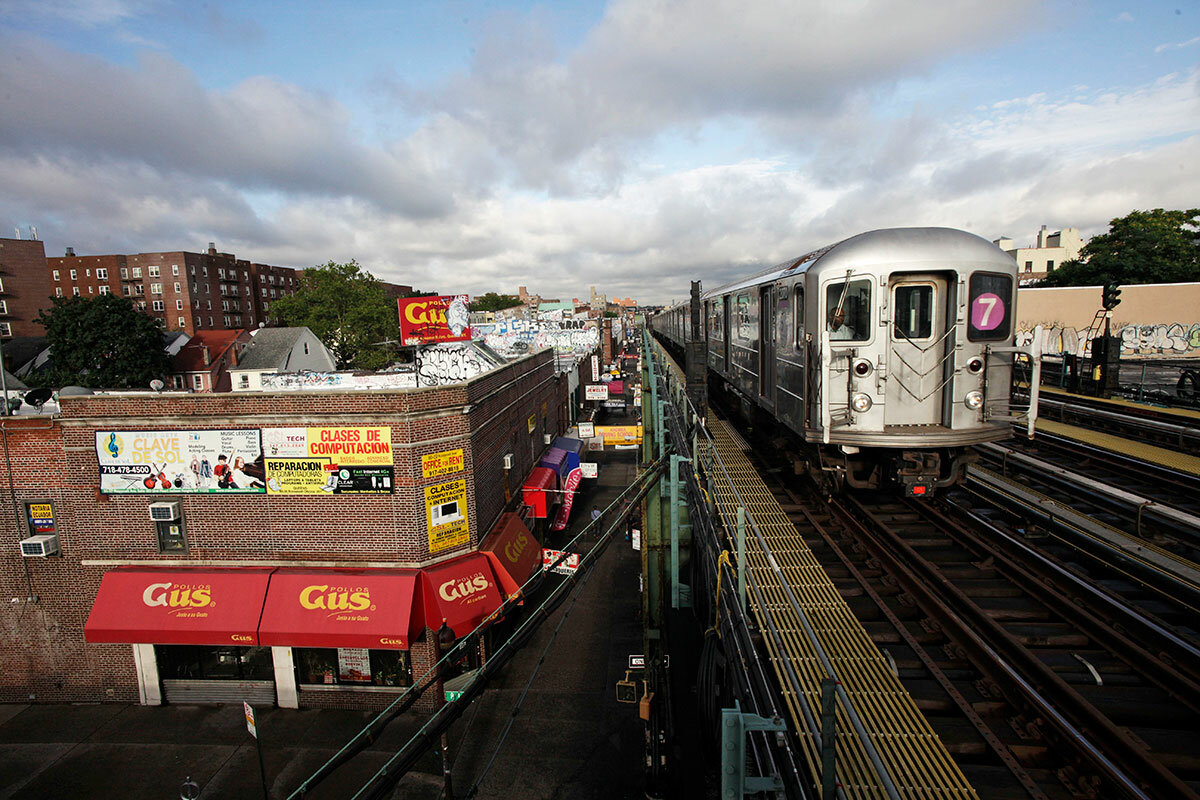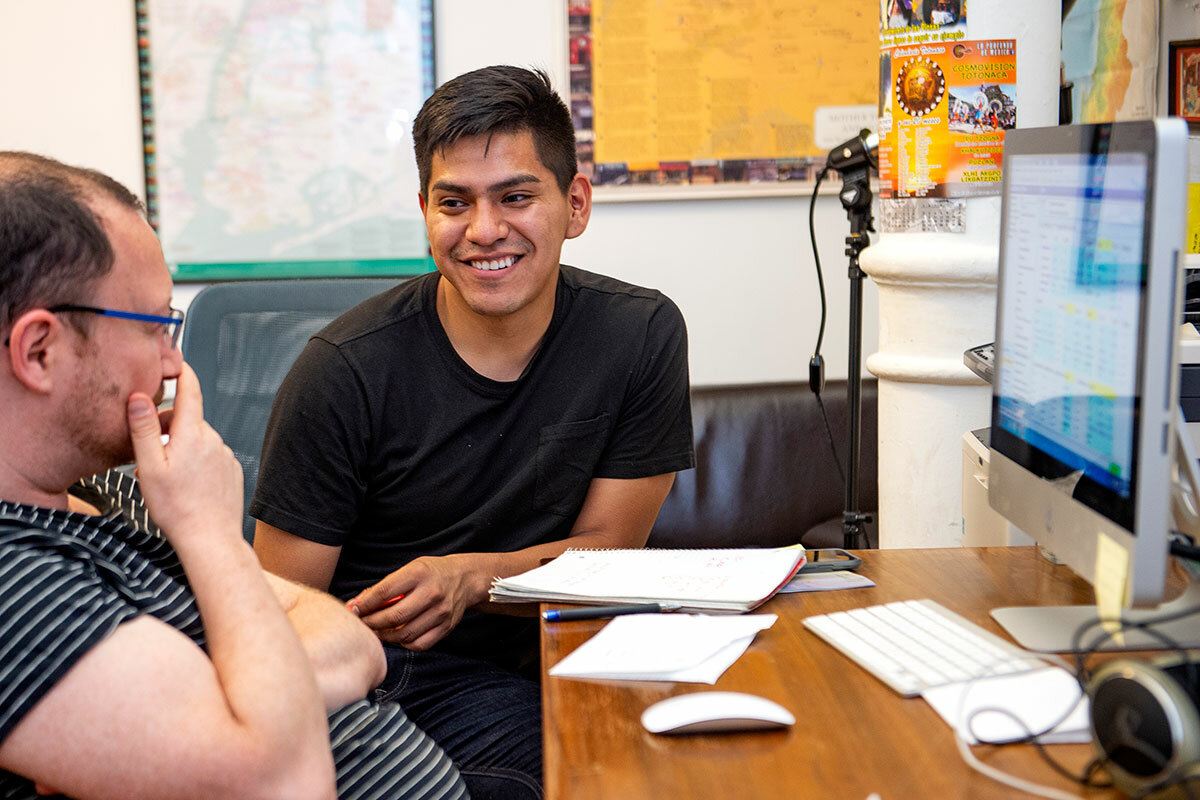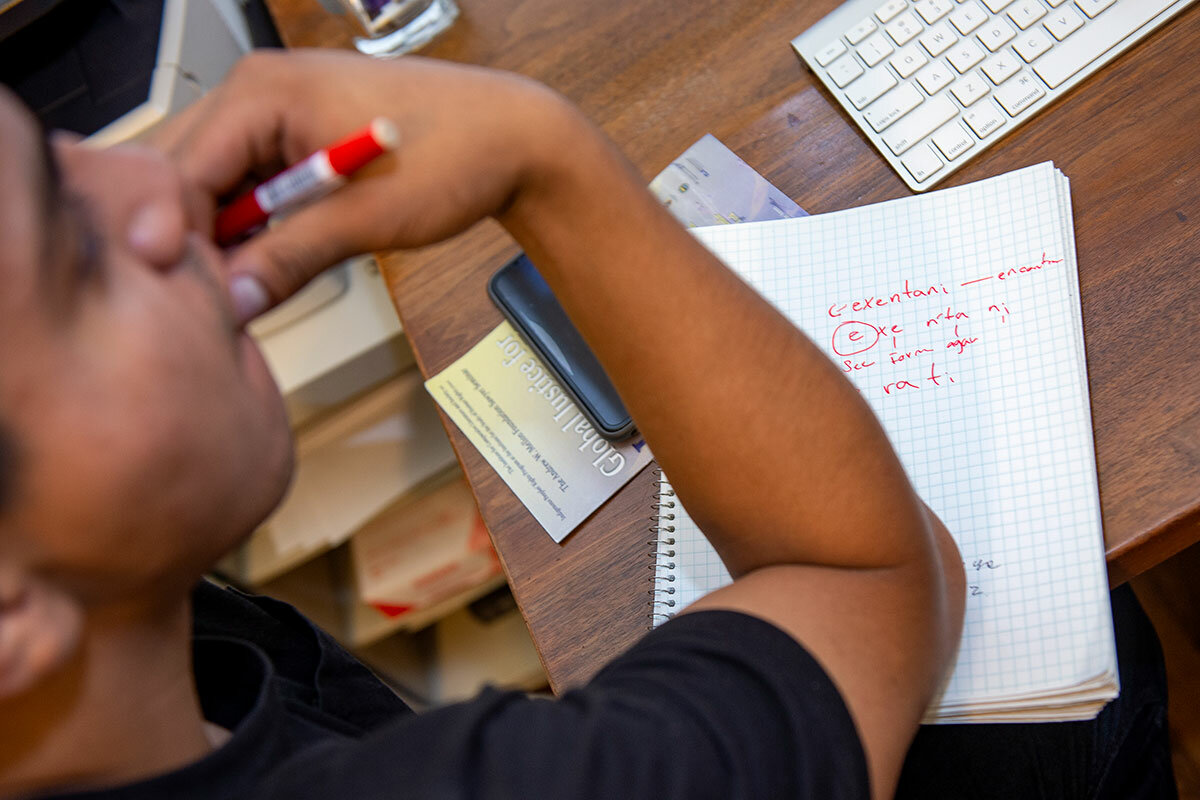Saving vanishing words: Why Queens is the ‘Noah’s Ark of languages’
Loading...
| New York
Like many immigrants who live near the busy subway hub in Jackson Heights, Tenzin Namdol usually talks to her family and friends with a shape-shifting array of tongues.
She’ll jump from colloquial Tibetan to standard English in the middle of a conversation almost without a thought, and then start speaking what she says has become a third hybrid of slang, combining the phonetics of both. She also speaks fluent Hindi, the language she prefers when hanging out in one of her Queens neighborhood’s famed local restaurants or one-of-a-kind shops.
Despite this easy fluency in a number of very different languages, Ms. Namdol becomes wistful when it comes to one she hasn’t quite mastered – the native tongue of her mother, whose people speak a rare Himalayan dialect called Mustangi.
Why We Wrote This
The loss of a single language, legendary linguist Kenneth Hale used to say, “is like dropping a bomb on the Louvre.” Saving the world’s rarest words means travel – hopping a subway to Queens.
There are only about 3,000 people left in the world who still speak Mustangi, and most live in a remote Himalayan region in western Nepal. But a few hundred or so of these speakers, including Ms. Namdol’s mother, now reside in the New York borough of Queens.
This also happens to be the most linguistically diverse neighborhood on earth, scholars say. With as many as 800 distinct languages, Queens has a diversity of tongues and dialects unprecedented in human history – and its epicenter is here amid the concentrated din of Jackson Heights.
Linguists estimate that up to half of the 7,000 languages spoken throughout the world today are likely to die off by the end of this century, most succumbing to a number of homogenizing forces in the modern world.
Global capitalism, digital media, as well as the long-standing political efforts of national leaders who’ve believed that a single, nation-binding tongue would only strengthen their country’s cultural cohesion and economic efficiency, are only a few of the reasons so many languages are disappearing today.
“Sadly, my mother didn’t pass down her language to me,” says Ms. Namdol, whose family lived among the Tibetan diaspora in Dharamshala, India, before emigrating to New York. “So it’s hard to really explain this right now, but it’s like, I feel I’m on the outskirts of my own community.”
In many ways, Ms. Namdol’s longings are part of a classic story of immigrants who come to New York. The city has long produced a literature of essays, memoirs, and novels written by new residents and first generation Americans who longed to find an elusive and self-grounding feeling of “home” – even as they chronicle the uneasy liberty America provides to put aside the past and invent the self anew.
Part of this classic story, too, has been the well-intended reactions of immigrant parents like her mother, who raised her daughter to speak the lingua franca of their wider community, the standard Tibetan used for commerce, government institutions, and the traditions of Buddhism. What use could a language like Mustangi offer her daughter?
“Now if I go to a gathering of my mother’s people, I’m not able to understand their words, so they don’t really identify me as one of their own because I don’t know their language,” says Ms. Namdol. “I want to feel connected. I want to sing with them. I want to dance with them. I want to share their stories and laugh with them. I can’t do that.”
Yet as she works through her ambivalent feelings about her “hybrid” identity, an identity particular to this sumptuous diversity of Queens, the recent college grad decided to join a wider-ranging effort to document and preserve the growing number of languages about to become extinct throughout the world.
For the past year, she has begun to learn the words of Mustangi, volunteering with the Endangered Language Alliance, a nonprofit in Manhattan that works with immigrant communities to preserve their dying languages.
Collecting the stories of local Tibetans in their native tongues, she’s been recording them for the alliance’s project “Voices of the Himalayas,” learning more about some of the other seven languages spoken in Jackson Heights’ Tibetan diaspora, including her father’s native tongue, Kyirong, a three-tone Tibetic language spoken mostly in Nepal.
‘Babel in reverse’
Jackson Heights is the perfect place to pursue such preservation efforts. Over the past decade, in fact, linguistics scholars have begun to focus more of their research on such urban immigrant communities, where in many cases there are more speakers of a rare language than in the region where it first evolved.
“This neighborhood in particular is like, I would say, the Noah’s Ark of languages,” says Daniel Kaufman, a professor of linguistics at Queens College and the executive director of the Endangered Language Alliance. Others have used another metaphor from Hebrew Scripture, calling New York “Babel in reverse,” its towers, in effect, acting as magnets for language diversity.
“We linguists talk about places like New Guinea and Vanuatu and Indonesia as having this incredible language density, a density that evolved naturally through a kind of linguistic ‘speciation,’” says Dr. Kaufman, who also heads Queens College’s new Language Documentation Lab. “But this area here came about through immigration.”
And it’s really just a coincidence, Dr. Kaufman says, that Jackson Heights happens to be at the crossroads of language diversity. The immigrant communities clustered here happen to be from countries that already have the most spoken languages in the world, including India, Nepal, the Philippines, and Mexico. Each of these countries has hundreds of indigenous communities that speak their own language.
There are also a number of rare European languages in pockets of Queens. In Astoria, a number of people still speak Vlaski, a Croatian-Istrian tongue that sprang from nomadic shepherds who settled in the Balkans in the 16th century. Most of the world’s remaining speakers of Gottscheer, a Germanic dialect in what is now Slovenia, reside in nearby Ridgewood. Bukhari, the language spoken by Jewish immigrants from Uzbekistan, has more speakers in Queens than in the old countries.
‘The essence of who we are’
Alex Paz, however, may be one of only a handful of people living in New York who speaks P'urhépecha, an indigenous pre-Columbian language spoken in southern Mexico.
Considered an “isolate” among human tongues, P'urhépecha is not only rare, but also one of a kind, linguistically unrelated to any other known language in the world.
“There are things that can only be said in my language,” says Mr. Paz, an immigrant from the small mountain town of Ocumícho in the Michoacán region of southern Mexico. “Even at home, I can see how my language is disappearing, and this means a lot of cultural aspects, too, because language – once we lose our language, I think that’s the essence of who we are.”
P'urhépecha is one of the 68 national languages recognized by the Mexican government, yet linguists say there are actually more than 200 indigenous languages spoken throughout Mexico, making Mexico one of the most linguistically diverse countries in the world.
Today, Mr. Paz, too, has been volunteering for the Endangered Language Alliance, trying to locate and collect everything that’s been written in P'urhépecha over the past few decades. And while he hasn’t found anyone else in New York who speaks his language, Mr. Paz has been immersed in it as he never has before, putting what he finds into a database and then providing word-by-word translations into English and Spanish – a complex and complicated task, he says, since many of his language’s words contain concepts nearly impossible to translate.
Though only in his 20s, he worries that he may be among the last to learn his people’s ancient tongue. After his family emigrated to Pennsylvania 10 years ago, his little sisters haven’t learned P'urhépecha. He learned the language as a child by speaking to his grandmother, who doesn’t speak Spanish. But since she still lives in southern Mexico, they rarely get the chance to see or talk to their grandmother now.
But it’s not simply nostalgia or the immigrant longing for home, however, that motivates efforts to preserve the world’s dying languages, linguists say. Like the evolution of creatures, the complexity of human language virtually defines the species, and every spoken tongue is rich with the experiences of humanity.
“The loss of local languages and of the cultural systems which they express, has meant irretrievable loss of diverse and interesting intellectual wealth,” wrote the legendary linguist Kenneth Hale. “Only with diversity can it be guaranteed that all avenues of human intellectual progress will be traveled.”
The loss of any one language, he used to say, “is like dropping a bomb on the Louvre.” When a language goes extinct, in many cases thousands of years of accumulated human knowledge are lost. Every language has enormous reserves of cultural, ecological, and even botanical information considered vital for local communities.
“This idea that sets of experiences became words and languages is not really correct, as if we’re just kind of setting old experiences to a set of new words,” says Dr. Kaufman. “When people get into the revitalization of indigenous languages, it’s really that those words have their own special use and their own special contexts, that really you’ll only ever learn experientially.”
Yet the ever-branching tree of human language has long been replete with slowly changing hybrids and offshoots that often meet their linguistic end. And since hunter-gatherer times, violence and cultural dominance have been a major part of the evolution of languages. Modern English, in fact, began to form after the invasion of William the Conqueror in 1066, and the subsequent cultural domination of French speakers in Anglo-Saxon lands.
Similarly, centuries of colonialism and myriads of nationalist projects in countries around the world during the 20th century created an active process of linguistic suppression and even elimination.
These external forces then gave rise to the more subtle internal forces that Ms. Namdol and Mr. Paz both know well: shame.
Even in the Tibetan communities in Nepal, there is a hierarchy of value attached to its many tongues. “We speak the Lhasa dialect, the standard Tibetan language, part of Buddhist religion, and if you speak Lhasa, then you are respected. Others are what you would call, I’d say, a village language,” says Ms. Namdol.
‘She wanted me to become my own person’
On the one hand, older Mustangi women often assert their generational identity by cluck-clucking the ways of the young, decrying what’s being lost in their culture. They tend to shame Ms. Namdol, however subtly, as an outsider. Yet at the same time, her mother made a conscious decision not to teach her daughter the language of her ancestors.
“There were a lot of layers to this, and from her perspective, she’s right,” Ms. Namdol says. “She didn’t want me to deal with a lot of the caste system that was involved in the society of Nepal itself, or even in India. So she wanted me to become my own person, separate from my own community.”
“But now we’re living in the generational world. We have to live in a cultural setting, and at the same time we have to adapt to the newer, modern world,” she continues. “But then we also have to stay grounded, while we have that pressure to stick with our culture and everything. Yet from a language perspective, we have a lot of people, the next generation, I would say, most of them, they don’t even speak Tibetan now.”
Mexico has made a lot of efforts to preserve its linguistic diversity over the past few decades, but Mr. Paz laments the educational policies that emphasize Spanish, and the similar kinds of shaming and intracultural racism when it comes to the country’s array of indigenous people and the marginalization they often feel.
“It’s like the language is the only thing that we have left, and its concepts,” Mr. Paz says. “I don’t want to read somewhere, or have to say, ‘Back in the day in Michoacán we used to speak this language, P'urhépecha.’ It’s sad, and I want to at least try to keep it alive, and to keep it real.”









